This post may contain affiliate links. Please read our disclosure policy.
Gluten free sablé cookies are simple slice-and-bake French-style buttery shortbread cookies. Crunchy outside, chewy inside, with sparkly coarse sugar all around.

What makes these sablé shortbread cookies different?
Classic shortbread cookies are made with butter, sugar, egg yolk, and flour. There's no leavening (baking soda, baking powder), because they're meant to be “short,” or crumbly.
“Crumbly” and “dry” don't sound great for baked goods, but I promise with these cookies it's in a good way! What makes these sablé cookies different from “regular” shortbread cookies is the texture both inside and outside.
These cookies are made with a slightly different balance of fat and flour, coated on the outside with coarse sugar, and sliced thickly. That means that they have a slightly crisp outer shell and the most tender, slightly chewy inside, all while still being properly crumbly.
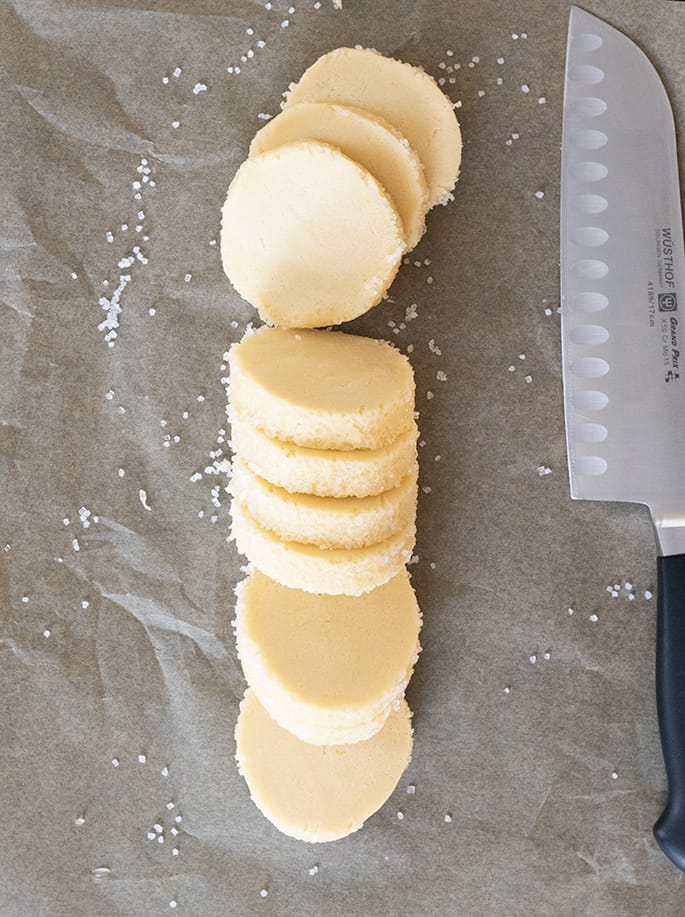
How to make gluten free sablé cookies
To get the proper texture for these cookies, you need to make the dough in either a stand mixer fitted with the paddle attachment, or a large bowl with a handheld mixer. If you have a stand mixer, use that because it's much easier to blend the ingredients without making a mess. ?
Place the (European?) butter, granulated sugar, egg yolk, and vanilla into your large mixing bowl and beat until well-combined but not fluffy. We don't want to add excess air to the dough, but we do want the ingredients to begin to emulsify, or combine into a smooth mixture with the fats broken up into droplets. Don't worry, the science doesn't at all matter, just the method!
Then, add the flour, salt, and cornstarch, and mix until just combined. The cookie dough will be thick and relatively stiff, but that room temperature butter isn't ready to be shaped properly into a log quite yet.
Place that dough in a large piece of plastic wrap or unbleached (flexible) parchment paper, and shape it loosely into a log about 1 1/2-inches in diameter. Chill it for at least 2 hours, but you can keep the dough in the refrigerator, chilling, for much longer than that.
You'll know that it's properly chilled when you touch the log in the center and even if feels firm. Shape into a proper round by rolling it back and forth on a flat surface and compressing the ends until they're blunt.
Next, moisten the outside of the log with wet hands, and roll it back and forth in coarse sugar to coat the outside completely. Slice it into about 10 pieces by cross-section, reshape each piece a bit into a round, and they're ready to bake.
If working with the dough has warmed it so it's no longer firm, just chill it again briefly. Bake the cookies for about 10 minutes at 350°F. The centers should be set (not glistening like they're wet) and the edges should be golden brown.
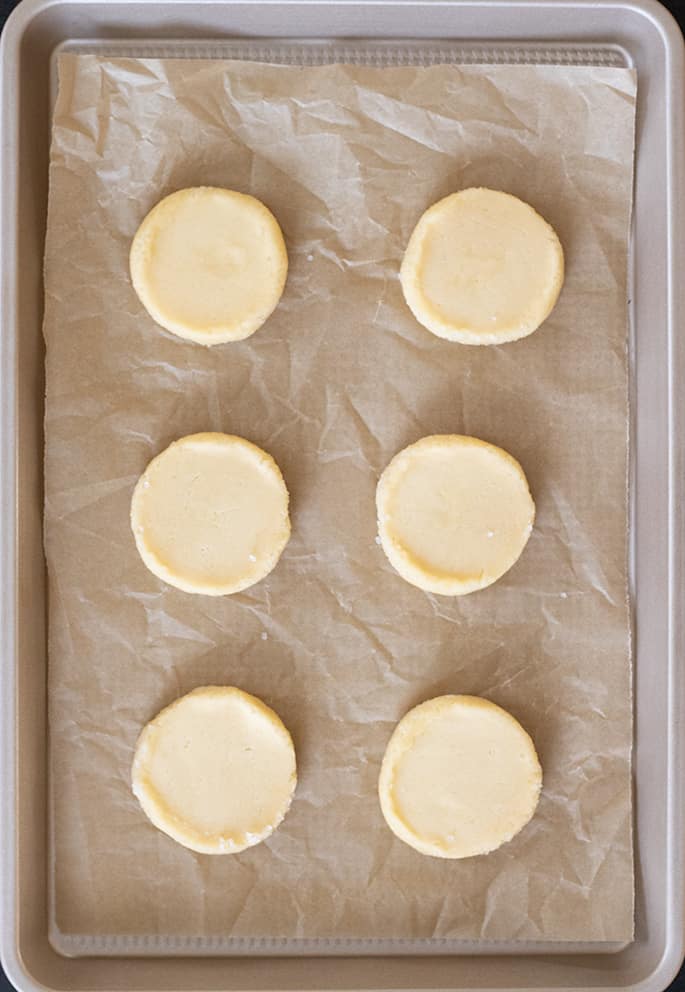
Do I have to use European butter?
The short answer is no, you don't have to use European butter. But let me make the case for it anyway.
European butter (which in my experience is often Irish, under the brand Kerrygold) has a higher butterfat content than traditional American butter. If Canadian or Australian butter is similar to European, then use that! It makes for a richer cookie that spreads less, since higher butterfat also means lower moisture.
I have in fact made these cookies with my trusty unsalted Trader Joe's butter (although Trader Joe's also carries Kerrygold), and they worked great. They were just missing a bit of richness, and they did spread a tiny bit more because of the higher moisture content. But it's not something I'd stress about.

Gluten free sable cookies ingredients and substitution suggestions
As with any super simple recipe, it's difficult to make substitutions without creating a completely separate recipe. But here are my educated guesses about the other potential allergens in these gluten free sablé cookies.
Dairy free
The two most important ingredients in this recipe are butter, and flour. Replacing either one of them is kind of a big deal, and makes me a little nervous that you aren't going to be successful.
But if you must replace the butter, I would recommend trying Melt brand vegan butter, my favorite butter replacement. If you can't find Melt, my second suggestion is half (56 g) Earth Balance buttery sticks and half (56 g) Spectrum brand non hydrogenated vegetable shortening.
See above for a complete discussion of whether or not you absolutely need to use European butter, if you aren't dairy-free.
Eggs
There's only one egg yolk in this recipe, and it adds richness and helps hold together the butter and sugar mixture. If you need to eliminate it, you can try using 2 tablespoons of Spectrum non hydrogenated vegetable shortening, which should help provide richness without moisture.
Cornstarch
If you can't have corn, try using arrowroot or even potato starch. Either should work just fine.
Gluten Free Sablé Cookies | French Shortbread
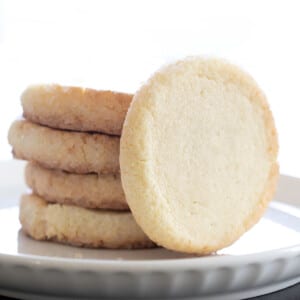
Ingredients
- 8 tablespoons (112 g) European unsalted butter, at room temperature
- 6 tablespoons (75 g) granulated sugar
- 1 (25 g) egg yolk, at room temperature
- 1 teaspoon pure vanilla extract
- ¼ teaspoon kosher salt
- 1 cup (140 g) all purpose gluten free flour, please click thru for full info on appropriate blends
- ½ teaspoon xanthan gum, (omit if your blend already contains it)
- ¼ cup (36 g) cornstarch
- Coarse sugar, for decorating
Instructions
- In the bowl of a stand mixer fitted with the paddle attachment or a large bowl with a hand mixer, place the butter, granulated sugar, egg yolk, and vanilla, and beat until well-combined, but not fluffy.
- Add the salt, flour, xanthan gum, and cornstarch, and mix until just combined.
- The cookie dough will be thick and relatively stiff. Transfer it from the mixing bowl to a large sheet of plastic wrap.
- Shape the cookie dough into a log about 1 1/2-inches in diameter. It will be too soft to shape properly, but do your best.
- Wrap the dough tightly in the plastic wrap and refrigerate until firm and easy to shape (at least 2 hours).
- Once the dough is fully chilled, remove it from the refrigerator and shape it into a proper cylinder with flat sides.
- Preheat your oven to 350°F.
- Line a large rimmed baking sheet with unbleached parchment paper and set it aside.
- Sprinkle 2 to 3 tablespoons of coarse sugar on a clean, flat surface.
- Moisten the outside of the log with wet hands, and roll it in the coarse sugar, pressing gently to help the sugar adhere to the cookie dough.
- Using a sharp knife, cut rounds by cross-section about 1/4-inch thick.
- Arrange the rounds about 1 1/2-inches apart on the prepared baking sheet.
- Reshape any of the cookies into a proper round in the palm of your hand as necessary.
- If the dough has warmed at all, place the baking sheet in the freezer or refrigerator until firm.
- Place the baking sheet in the center of the preheated oven and bake until the tops are set and the cookies are lightly browned around the edges (about 10 minutes).
- Allow the cookies to cool on the baking sheet for 10 minutes before transferring to a wire rack to cool completely.
Video
Nutrition information is automatically calculated, so should only be used as an approximation.



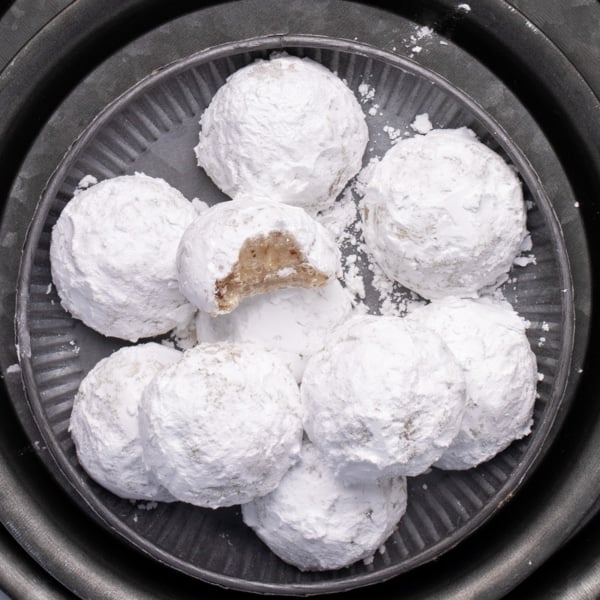
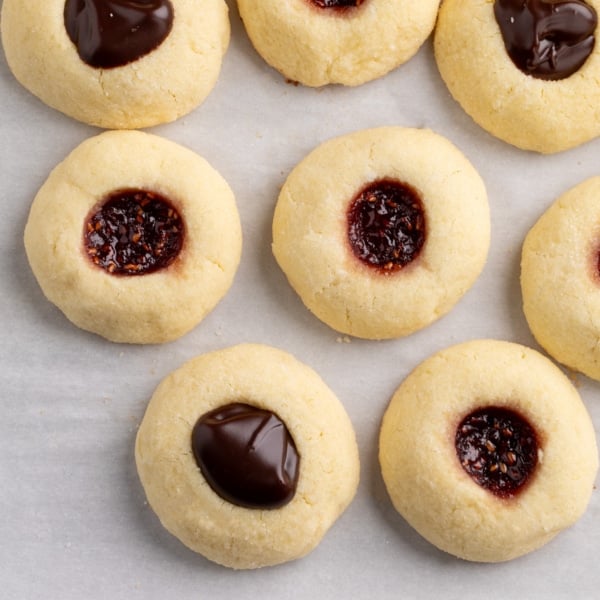










With these, does it matter if the flour is mock better batter or better than cup 4 cup?
If you use Better Than Cup4Cup (really, my favorite blend), Robin, you should use a full 1 1/4 cups (175 g) Better Than Cup4Cup and omit the cornstarch. Up to you, though!
I’m not sure the instructions are correct. A 1 1/2 ” diameter log is really long. I made mine bigger, even then I got way more than 10 cookies at 1/4″ thick. Was it supposed to be 3″ diameter (1 1/2″ radius)? Also mine took longer to bake and never browned. I took them out at 14min. Probably should have left them in longer.
I used Kerrygold butter and Bob’s red mill 1-1 GF flour for reference.
Hi, Andi, I’m certain it’s not 3-inches in diameter. I’m afraid Bob’s Red Mill flour will not work in any of my recipes that call for an all purpose gluten free flour. It’s unbalanced and gritty.
My daughter is 18 now been type 1 Diabetic since 2 1/2yrs old and been diagnosed with Celiac’s for a year now.. Ironically on anniversary of Diabetes diagnosis!
Hi
Is it ok to use swerve instead of sugar?
Thanks!
Rita
I haven’t used a sugar replacement with these cookies, Rita, but since there actually isn’t that much sugar in the actual cookies I think it might work. Sugar substitutes do tend to be drying, though, so be careful about the consistency of the dough. You may need to add a bit of moisture. I’ve heard really good things about So Nourished sugar substitute, which is supposed to lack that cooling sensation that most have. I’m excited to try that one out, if you’re interested.
Thank u so very much for the recipes they sure help people like me who are afraid to bake thinking I can’t do this it’s too complicated but with your recipes I am so excited to be able to bake again my daughter bought me my first scoops can’t wait to try them out all thanks too you Nicole thank you very much your baking friend Sharon
You can absolutely do it, Sharon! I promise. A simple recipe like this with so few ingredients is a great place to begin. ?